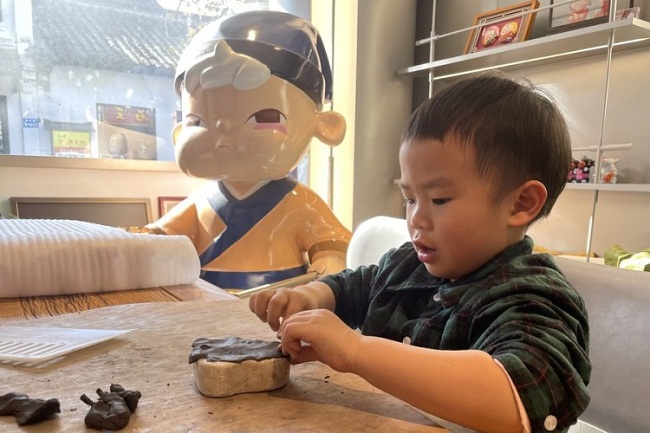Clay figurines get new lease of life in east China

A boy tries to make a Huishan clay figurine at a NANIMOMO Cafe in Wuxi City, east China's Jiangsu Province, Jan. 10, 2023. (Xinhua/Zhu Guoliang)
NANJING, April 14 (Xinhua) -- A new chain of coffee shops has sprung up in the city of Wuxi, east China's Jiangsu Province, themed on the ancient Huishan clay figurine culture -- with a few modern adaptations.
The NANIMOMO Cafe chain has expanded rapidly since May last year, despite the pandemic, and now has 11 branches in operation. The coffee shops display a range of figurines and related cultural and creative products. In addition to drinking coffee, visitors can have a go at making clay sculptures on site if they like.
Huishan clay figurines are made of the black clay found at the foot of Huishan Mountain in Wuxi. They are said to have a recorded history of more than 400 years and are listed in the first batch of China's national intangible cultural heritage in 2006. In Wuxi dialect, Huishan clay figurines are pronounced "NANIMOMO."
Originally, the figurines were made by the local residents at the foot of Huishan Mountain during the slack farming season. Later, professional workshops emerged in Huishan, with the production peaking in the Ming (1368-1644) and Qing (1644-1911) dynasties. However, the tradition subsequently went into decline.
In 1954, the local government organized artists and workshops and set up a cooperative to produce Huishan clay figurines. Four years later, the Huishan clay figurine factory was officially established, and the industry was revived.
In its heyday, the factory had nearly 1,000 people creating, designing, producing and selling clay figurines. The products were sold at home and abroad, with Japan a major export destination. Then, in the last decade, the market for traditional clay figurines -- which were relatively simple in shape and low in production efficiency -- gradually shrank.
The number of employees was much reduced, and it was difficult to attract young people to learn the craft, according to Zhou Hanqing, a senior artist at the factory.
In recent years, however, Wuxi has carried out a series of reforms and innovations in the cultural field, including introducing private capital to revive traditional cultural industries and promoting the inheritance of intangible cultural heritage projects.
In 2020, the Huishan clay figurine factory was taken over by a private enterprise in Wuxi. The factory seized the opportunity to integrate traditional intangible heritage culture with emerging coffee culture as a means of reviving the industry. NANIMOMO Cafe was born two years later.
"More and more young people love coffee, and integrating the display and experience of Huishan clay figurines into the coffee shop brings this intangible cultural heritage to the attention of young people again," said Song Xilian, head of operations at NANIMOMO.
The two most famous traditional figurines are "A Fu" and "A Xi," meaning "good fortune" and "joy". Now, the factory has designed and produced several new figurines, such as NANI and MOMO, which are more modern and attractive to young consumers. There are also several cute and colorful characters carrying different types of food for which Wuxi is famous: spareribs, peaches and steamed buns.
In addition, a wide range of cultural and creative products, from school supplies to daily necessities, featuring the images of Huishan clay figurines, are now being sold. The factory has even signed contracts with local companies to design clay figurines for their brands.
Through such innovations, the factory has been turning a good profit recently.
This year, Wuxi proposed in the government work report that it would implement the innovation project for intangible cultural heritage to expand the influence of Xiju, also known as Wuxi Opera, red stoneware, Huishan clay figurines, fine embroidery and bamboo carving. The Huishan clay figurine industry is expected to be developed further.
"There is no contradiction between inheritance and innovation. Only by integrating intangible cultural heritage into modern life can we improve protection and inheritance," Zhou said.

 WeChat
WeChat
 Weibo
Weibo